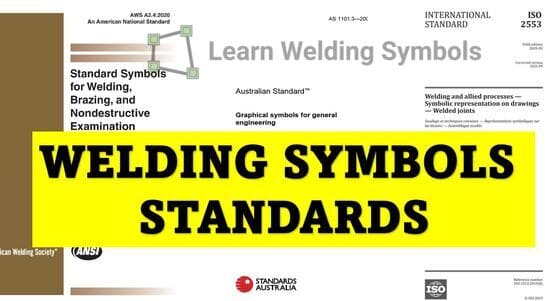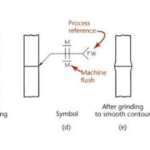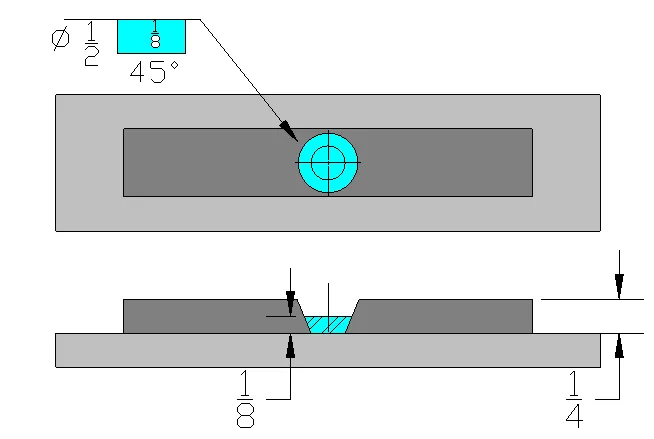When checking a welding blueprint, you may come across the terms “welding symbol” and “weld symbol.” While they may sound similar, it’s important to note that they refer to different symbols and concepts.
According to the AWS A3.0M/A3.0:2020 standard, which covers welding terms, definitions, and related processes, these two terms should not be used interchangeably.
In this blog post, we will understand the distinction between weld symbols and welding symbols, shedding light on their definitions and usage.
Understanding Welding Symbols
In accordance with AWS A3.0:2020, a welding symbol is defined as “A graphical representation of the specifications for producing a welded joint.” A welding symbol consists of various components, including the horizontal reference line, arrow and a Weld symbol.

These elements convey essential information about the weld joint. Additionally, welding symbols may incorporate supplementary symbols and information in the tail to provide further details.
Exploring Weld Symbols
On the other hand, a weld symbol, as defined by AWS A3.0:2020, is “A graphic character connected to the reference line of a brazing or welding symbol specifying the joint geometry or weld type.”
In essence, a weld symbol is a specific component within a welding symbol. It serves to denote the joint geometry or type of weld being employed.
In AWS A2.4, weld symbols are classified into:


Differentiating Between Weld Symbol and Welding Symbol
To summarize,:
- a welding symbol encompasses the complete representation of specifications for producing a welded joint. It comprises various elements, including the horizontal reference line, arrow, and optional supplementary symbols.
- On the other hand, a weld symbol is a part of the welding symbol and focuses specifically on indicating the joint geometry or weld type.
Weld Symbol vs Welding Symbol
| Weld Symbol | Welding Symbol |
|---|---|
| Graphic character connected to the reference line of a brazing or welding symbol specifying the joint geometry or weld type. | A graphical representation of the specifications for producing a welded joint. |
| Indicates the joint geometry or type of weld being employed. | Encompasses the complete representation of specifications for producing a welded joint. |
| Is a specific component within a welding symbol. | Comprises various elements, including the horizontal reference line, arrow, and optional supplementary symbols. |
| Provides concise information about the weld type or joint configuration. | Conveys detailed specifications for the production of the weld joint. |
| Typically depicted as a geometric shape, such as a fillet, groove, plug, or spot weld symbol. | Includes the weld symbol along with other components like the reference line, arrow, dimensions, tail, and supplementary symbols. |
| Used to specify the joint geometry or weld type in a welding symbol. | Used to communicate the complete set of requirements for producing a welded joint. |
| Does not provide comprehensive information about the welding process or additional details. | Can incorporate supplementary symbols and information in the tail to convey additional specifications or instructions. |
Standards for Welding Symbols and Welding Terminology
To ensure standardized usage and understanding of welding symbols, professionals in the welding industry should refer to the AWS A2.4:2020 standard, which provides detailed guidelines and graphics depicting the meaning and usage of welding symbols.
It is essential to stay updated with the current version of this standard to accurately interpret and communicate welding specifications.
Furthermore, the AWS A3.0:2020 standard is crucial for welding vocabulary, offering comprehensive definitions and terms related to welding processes. Interested individuals can access this standard on the ANSI Webstore.
Elements of a welding symbol
A welding symbol consists of several key elements that convey important information about the weld joint and welding process. These elements are standardized and commonly used in welding drawings and specifications.
Here are the essential components of a welding symbol:
- Reference Line: The reference line is a horizontal line that serves as the foundation for the welding symbol. It indicates the location and orientation of the weld joint.
- Arrow: The arrow points to the location where the weld is to be performed. It connects to the reference line and indicates the direction in which the weld should progress.
- Weld Symbol: The weld symbol is a graphic representation that provides information about the specific type of weld to be used. It can take various shapes and forms, such as fillet, groove, plug, or spot weld symbols.
- Dimensions: Dimensions are often included in the welding symbol to specify the size, length, or depth of the weld. These dimensions indicate the requirements for the weld size or penetration depth.
- Tail: The tail of the welding symbol contains additional information about the weld, such as welding process specifications, welding consumables, or any specific instructions related to the weld joint.
- Supplementary Symbols: Supplementary symbols are optional elements that may be included in the welding symbol to provide further details. They can indicate specific weld characteristics, such as the need for preheating, post-weld heat treatment, or any other special requirements.
Conclusion
In conclusion, while the terms “welding symbol” and “weld symbol” are often used interchangeably, they represent distinct symbols in the field of welding. A welding symbol encompasses the entirety of specifications for a welded joint, while a weld symbol specifically indicates the joint geometry or weld type within the welding symbol.
By understanding the difference between these two terms, professionals can effectively communicate welding requirements and ensure accurate interpretation of welding symbols in various engineering applications.







